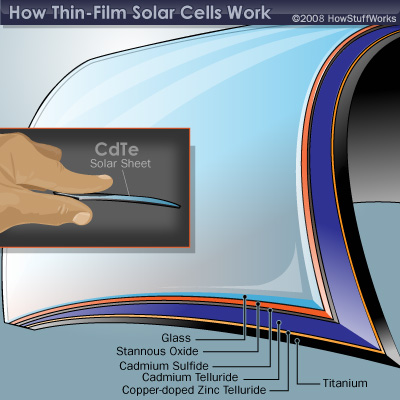Pv solar cells based on cdte represent the largest segment of commercial thin film module production worldwide.
Cadmium telluride photovoltaic solar panels.
Cadmium telluride is a direct bandgap material with bandgap energy of about 1 45 defined ev which is well matched to the solar spectrum and nearly optimal for converting sunlight into electricity using a single junction.
It is usually sandwiched with cadmium sulfide to form a p n junction solar pv cell.
Cadmium telluride cdte is a stable crystalline compound formed from cadmium and tellurium.
The benefits of cdte thin film solar cells include.
Cadmium telluride cdte and copper indium gallium diselenide cigs.
Cadmium telluride solar cells.
The united states is the leader in cadmium telluride cdte photovoltaic pv manufacturing and nrel has been at the forefront of research and development in this area.
Development of cdte as a solar cell material dates back to the early 1980s when 10 efficient devices were demonstrated.
Cdte thin film panels are made from several thin layers.
New cadmium telluride solar panels are now available for applications on tall buildings in urban environments.
First solar a us based manufacturer makes attractive pv modules that can be used in home applications.
There are two main types of thin film pv semiconductors on the market today.
Cadmium telluride cdte is the most commercially successful thin film photovoltaic technology.
Cadmium telluride cdte is the most common type of thin film solar cell in production.
The question of what happens when indictments of current energy sources are also levied towards alternative sources is an important one.
Their efficiency ranges from 15 3 to 18 2 with 110 w to 450 w of power output.
Normally thin film cells have quite a bit lower efficiency than c si cells but the latest products from first solar have a 14.
Cadmium telluride cdte photovoltaics describes a photovoltaic pv technology that is based on the use of cadmium telluride in a thin semiconductor layer designed to absorb and convert sunlight into electricity.
As the second most common photovoltaic technology on the market behind traditional crystalline silicon cadmium telluride cdte panels are already a viable thin film solar panel solution.
A thin film solar cell is made by depositing one or more thin layers of pv material on a supporting material such as glass plastic or metal.
One main energy producing layer made from the compound cadmium telluride and surrounding layers.
Advancements in solar technology and the rapidly expanding landscape of photovoltaic arrays are raising concerns about environmental toxicity namely the use of cadmium telluride cdte in most photovoltaic pv solar cells.
Typically cdte pv cells use a n i p structure.

